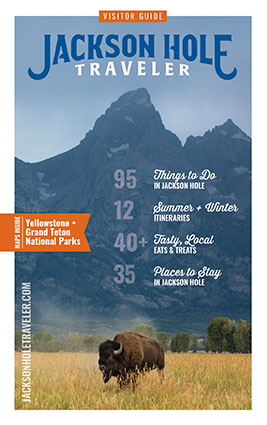Teton Science School Biologist Paul Brown has a nose for sniffing out wildlife and a mind full of data about the 67 species of mammals—including the endangered gray wolf—that dwell in the Greater Yellowstone Ecosystem. “I dare anyone to try and stump Senior Biologist Paul Brown!” says one of his reviews on TripAdvisor. Before moving to Jackson Hole in 2001, Paul worked for the U.S. Forest Service and New Jersey Audubon. He also guided polar bear expeditions in Manitoba, Canada.
Teton Science School biologist and wildlife tour guide Paul Brown loves where he lives and what he does. So an ideal winter day for him would be to share his love of wildlife and nature by leading or joining a snow coach expedition into Yellowstone National Park. The Park is closed to regular traffic in the winter, but luckily guided tours are available.
Paul was blown away by the outdoor opportunities in Jackson when he first ventured west from New Jersey. “After seeing my first wolves and bears I just knew I had to live here."
Skiing is great, but there’s so much more to do here in Jackson Hole in the winter. You can even take a 4-hour tour to Grand Teton National Park and see most of the region’s ungulates, or hoofed mammals.
“There is no better time than winter to see wildlife,” Paul emphasizes. And you don’t have to go far to find them.
Where to Stay in Jackson Hole?
The Lexington Hotel on Cache St. is a stone’s throw away from Jackson’s Town Square and a short bus ride away from The National Elk Refuge, which offers some of the area’s best wildlife viewing opportunities in the winter. The Lex also offers a good coffee and continental breakfast with egg, ham, and cheese croissants for an early morning start up to Yellowstone.
What to Eat in Jacskon Hole?
Yellowstone can be a “big day.” This makes meals a bit tricky—a brown bag lunch is really the only choice. He also loves the sushi next door to the Lexington at Nikai. If it’s late and he’s tired, he heads to Pinky G’s for a slice of pizza.
Wildlife Sightings
Don’t blink. The opportunity to see waterfowl like trumpeter swans is only a few hundred yards out of town. “Most of the wildlife in the area can be seen on the elk refuge,” Paul says. "You’ll see elk herds, deer on the hillsides. You can even see them from hotels in town.”
Paul counted 55 pronghorn antelope this fall on the refuge. The winter will be tough on them with their small frames and shorter legs. On the inner road at the end of Broadway, there are often bighorn sheep and an occasional mountain lion around Miller Butte. One of Paul’s most storied personal sightings was witnessing a badger on Miller Butte scaring a young mountain lion away from a fresh kill.
Driving up to the parking lot at the National Museum of Wildlife Art is another great place to stop and pull out binoculars to look for coyotes and wolves on the refuge.
Yellowstone National Park is about 56 miles north of town, but can take two to three hours of driving time, depending on the roads. During the winter, wildlife tend to gather at lower elevations out of the deep snow and huddle together, making it easier to spot them. In the summer, the window to see wildlife is much smaller. With many more people trying to see them and scaring them away by midday, they can often be tougher to find.
Some of Paul’s favorite winter sightings are of the wolves, whose breeding season is in February. “Pair bonding starts up in December, January,” he says. “They begin dispersing and looking for mates. Sometimes we get to hear howling. Sometimes we see battles.”
As it gets colder, bison will often gather around Yellowstone’s thermal features like Old Faithful Geyser where they have access to food and can conserve energy, he says.
Then there is the snowy scenery to consider as well – the frost around the geyser basins and the deep, un-tracked snowfields. “You really get a sense for being in the place without the crowds and battling for opportunities.”
Best Place to Take a Photo?
It depends on the snow plowing, Paul says. But he loves the view of the Tetons from the Snake River Overlook or Elk Ranch Flats.
The regular road to Yellowstone National Park ends at Flagg Ranch where the new eco-friendly Mercedes snow coach that Teton Science Schools rolled out this year is kept. The vehicle on tracks runs on eco-diesel fuel with low emissions and has roof hatches to maximize viewing opportunities.
“You almost can’t take a bad photo in the winter around here,” Paul says.
Local Wildlife Viewing Tips
- Keep your feet dry with insulated and well-lined boots that aren’t too tight. (Teton Science Schools loans pack boots). Bring extra socks.
- Wiggle your toes.
- Pack a down coat for an outer layer.
- If you don’t have time for a wildlife tour, take the bus to St. John’s Hospital and enjoy a pleasant walk down the inner Elk Refuge Road by Miller Butte.
"You can walk 20 minutes outside Jackson and be in the wilderness,” Paul says, adding that Cache Creek is another great walk.
About our Author: Julie Kling is a freelance writer who lives in one of the most beautiful places on earth, Jackson Hole, WY. She teaches skiing at Jackson Hole Mountain Resort, practices yoga almost every day and is the mother of two children who love to go fast and take chances.

